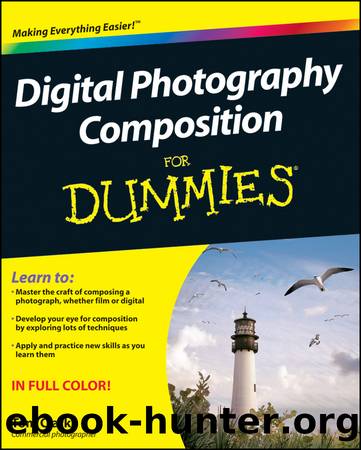Digital Photography Composition For Dummies by Thomas Clark

Author:Thomas Clark
Language: eng
Format: epub
Publisher: Wiley
Published: 2010-10-03T16:00:00+00:00
50mm, 1/640 sec., f/4, 100
Figure 10-3: Reducing contrast by increasing the intensity of your fill light.
Using strobes (instead of the sun) to light your scene puts you in total control and enables you to maintain consistent lighting throughout the shoot. In the most basic situation, you have a directional key light and a fill light. You can use light modifiers to control the quality of your light, and you can control the intensity of your fill light in comparison with that of the key light to manipulate your contrast in the scene. (I discuss strobes and light modifiers in the preceding section.) Your strobes have dials, slides, or switches that allow you to increase or decrease the amount of light they produce during each pop.
The Relationship between Light Source and Subject
Light quality and intensity (which I discuss earlier in the chapter) are important ingredients when creating appropriate lighting for your photo’s message. The third ingredient is the physical relationship of the light source to the subject. The position and distance of your lights in relation to your subject control many aspects of your achieved look and how you represent the subject.
In this section, I examine how the distance and position (or lighting pattern) of a light source can affect the quality of light it provides and change the way you see a subject. I also provide some information to help you add a third light source and experiment with breaking the traditional lighting patterns for creativity.
Seeing how distance makes a difference
A larger light source creates softer light. Luckily, if you can’t increase the size of your light source, you can simply move it closer to your subject. Doing so softens the light by increasing its surface area in relation to the subject.
On a similar note, the closer a light source is to a subject, the more intense the light becomes. So, if you want to keep the same level of contrast you had before moving the light, you may need to reduce the intensity of the light after moving it.
On the other hand, the farther a light source is from the subject, the harder the light will be. Consider the sun as a light source. If it were really close to you, it would be large enough to send light from many different angles and would cover you with a soft light quality (but, unfortunately, its nearness would cause all sorts of tragedy as well). But, because the sun is really far away, it’s small in comparison to you on earth and provides light only from a specific angle. Therefore, because of its distance, the sun provides hard light.
Imagine that you’re working with strobes and using a soft box to soften your key light. And say you want to soften the light more, but you’re already using the largest soft box you own. In this case, simply move your strobe closer to your subject. Doing so gives you a softer quality of light but also a more intense light.
Download
This site does not store any files on its server. We only index and link to content provided by other sites. Please contact the content providers to delete copyright contents if any and email us, we'll remove relevant links or contents immediately.
Shoot Sexy by Ryan Armbrust(17138)
Portrait Mastery in Black & White: Learn the Signature Style of a Legendary Photographer by Tim Kelly(16483)
Adobe Camera Raw For Digital Photographers Only by Rob Sheppard(16383)
Photographically Speaking: A Deeper Look at Creating Stronger Images (Eva Spring's Library) by David duChemin(16158)
Bombshells: Glamour Girls of a Lifetime by Sullivan Steve(13107)
Art Nude Photography Explained: How to Photograph and Understand Great Art Nude Images by Simon Walden(12346)
Perfect Rhythm by Jae(4621)
Pillow Thoughts by Courtney Peppernell(3394)
The Book of Joy by Dalai Lama(3217)
Good by S. Walden(2912)
The Pixar Touch by David A. Price(2739)
Fantastic Beasts: The Crimes of Grindelwald by J. K. Rowling(2542)
A Dictionary of Sociology by Unknown(2516)
Humans of New York by Brandon Stanton(2378)
Read This If You Want to Take Great Photographs by Carroll Henry(2301)
Stacked Decks by The Rotenberg Collection(2270)
On Photography by Susan Sontag(2128)
Photographic Guide to the Birds of Indonesia by Strange Morten;(2088)
Insomniac City by Bill Hayes(2082)
